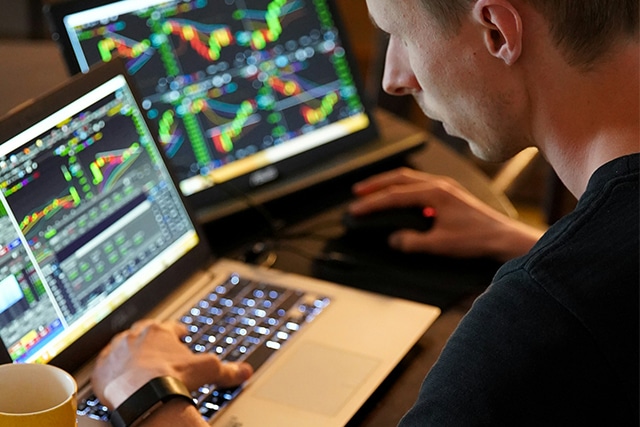What Is Day Trading? A Beginner’s Guide to This Fast-Paced World


Day trading is an exciting, fast-paced way to approach the financial markets. Whether it’s stocks, cryptocurrencies, or other assets, this trading strategy is all about buying and selling within the same trading day, aiming to profit from small price movements. It’s not your typical “buy and hold” investment strategy—it’s intense, requires focus, and can be risky. But for those who master it, the rewards can be significant.
Let’s examine how it works, and whether it might be the right fit for you.
What Is Day Trading?
This type of trading is all about speed and precision. Traders buy and sell financial assets — like stocks, options, or commodities — and close all positions by the end of the day. The goal is to make money from the tiny price changes throughout the day, often in highly liquid markets.
This approach differs greatly from long-term investing, where people wait for their assets to grow over time. It thrives on volatility, using rapid decision-making and market analysis to turn small price swings into potential profits.
How Does Day Trading Work?
Here’s a simple rundown of how day trading plays out:
Short-Term Moves
Day traders focus on short-term market fluctuations, holding assets for minutes or hours. All trades are wrapped up by the end of the day to avoid unexpected risks from overnight news or events.
High Liquidity
Day traders stick to highly traded assets like major stocks (think Apple, Tesla, or Amazon) or big cryptocurrencies (like Bitcoin or Ethereum). High trading volume ensures they can quickly buy or sell without much hassle.
Leverage
Many day traders use borrowed money (leverage) to increase their buying power. While this can amplify profits, it also magnifies losses—making proper risk management essential.
Tools and Analysis
Success often involves using charts, patterns, and indicators to predict price movements. Tools like moving averages, Relative Strength Index (RSI), and Bollinger Bands are staples in a day trader’s toolkit.
Why Do People Enjoy Day Trading?
Potential for Quick Profits
If you play your cards right, day trading can be very profitable, especially in volatile markets.
No Overnight Surprises
Day traders don’t hold positions after the market closes, so they avoid risks tied to overnight news or unexpected market events.
Flexibility
It allows for independence. You can work from anywhere with a computer and internet connection.
What Are The Potential Disadvantages of Day Trading?
High Risk
Let’s be real: Not everyone wins. Many new traders lose money because they underestimate how much skill and discipline it takes.
Time-Consuming
This type of trading is like having a full-time job. You’ll spend hours watching charts and monitoring the markets.
Emotional Rollercoaster
The fast pace and high stakes can be stressful, especially during volatile trading days.
Popular Day Trading Strategies
It is often best to stick to specific strategies to stay consistent. Here are a few that beginners might find useful:
Scalping
Scalping involves making many tiny trades throughout the day, aiming for small, quick gains. Scalpers often trade dozens or even hundreds of times daily.
Momentum Trading
Momentum traders ride the wave of big price movements. They jump on stocks with strong trends—often driven by breaking news or high trading volume—and exit before the trend reverses.
Breakout Trading
Breakout traders watch for stocks breaking out of a price range and aim to profit from the following surge.
Reversal Trading
This strategy focuses on spotting when a price trend is about to reverse, like when a stock is overbought or oversold.
Essential Tools for Day Trading
If you’re considering day trading, you’ll need the right tools to keep up with the fast-moving markets:
Day-Trading Simulators
A day trading simulator can help you prepare for real-world trading without any risks.
Trading Platforms
Platforms like TD Ameritrade’s thinkorswim, E*TRADE, or Robinhood give you access to the markets, charts, and technical tools you’ll need.
Real-Time Data Feeds
Speed is everything. You need accurate, up-to-the-second data to make quick decisions.
Risk Management Tools
Tools like stop-loss orders can limit losses if a trade doesn’t go your way.
Educational Resources
There’s no shortage of online courses, trading communities, and forums to help you learn the ropes.
Is Day Trading Right for You?
This type of trading isn’t for the faint of heart. Here are some things to consider before diving in:
In the U.S., you’ll need at least $25,000 in your account to meet the Pattern Day Trader (PDT) rule for active trading.
Successful investors stick to their strategies, avoid emotional decisions, and have a clear plan for managing risk.
Finally, this type of trading involves a steep learning curve. It’s not just about placing trades—it’s about understanding market patterns, timing, and psychology.
Are You Ready To Get Started?
Day trading can be an exhilarating way to approach the markets, but it’s far from easy money. Success takes time, dedication, and a lot of practice. Beginners should learn the fundamentals, test strategies with simulated accounts, and keep their expectations realistic.
If you’re willing to put in the effort, it can offer a unique opportunity to make profits while enjoying the freedom of working independently. However, it’s best to tread carefully if you’re diving in purely for the thrill or quick wins. As with any high-stakes venture, the risks are real — and for the disciplined, the rewards can be well worth it.









